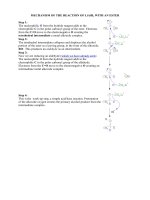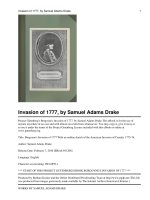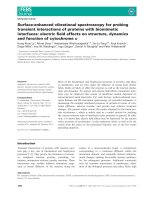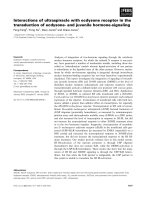Interactions of viologens with conducting polymers, metal salt solutions and glucose oxidase
Bạn đang xem bản rút gọn của tài liệu. Xem và tải ngay bản đầy đủ của tài liệu tại đây (3.13 MB, 223 trang )
INTERACTIONS OF VIOLOGENS WITH
CONDUCTING POLYMERS, METAL SALT SOLUTIONS
AND GLUCOSE OXIDASE
ZHAO LUPING
NATIONAL UNIVERSITY OF SINGAPORE
2004
INTERACTIONS OF VIOLOGENS WITH
CONDUCTING POLYMERS, METAL SALT SOLUTIONS
AND GLUCOSE OXIDASE
ZHAO LUPING
(B. Eng, Qingdao Institute of Chemical Technology)
A THESIS SUBMITTED
FOR THE DEGREE OF DOCTOR OF PHILOSOPHY
DEPARTMENT OF CHEMICAL & ENVIRONMENTAL
ENGINEERING
NATIONAL UNIVERSITY OF SINGAPORE
2004
Acknowledgement
ACKNOWLEDGEMENT
First and foremost, I would like to express my deepest gratitude to my supervisors,
Professor Neoh Koon Gee and Professor Kang En-Tang for their inspired guidance,
invaluable advice, and constant supervision throughout the length of my candidature. I
gratefully acknowledge the research scholarship offered to me by the National
University of Singapore (NUS), which enabled me to pursue my Ph.D. program.
Special thanks are due to Dr. Zhang Yan and Dr. Li Sheng. They have been most
helpful to me, both technically and personally. I enjoyed and benefited tremendously
from the discussion on my project and their invaluable suggestions and advices. I
would like to thank our group members like Dr. Lin Qidan, Mr. Ying Lei, Miss Cen
Lian for sharing the research experience with me. Particular acknowledgements go to
Madam Chow Pek and other lab technologists of Department of Chemical and
Environmental Engineering for their assistance and help.
Last but not least, I must express my deepest love and gratefulness to my family for
their long-term concern and support. In addition, special thanks to my wife, Huang
Yuehong, for her persistent love and encouragement.
Zhao Luping
i
Table of Contents
TABLE OF CONTENTS
ACKNOWLEDGEMENT i
TABLE OF CONTENTS ii
SUMMARY vi
NOMENCLATURE ix
LIST OF FIGURES xi
LIST OF TABLES xvi
CHAPTER 1 INTRODUCTION 1
CHAPTER 2 LITERATURE SURVEY 7
2.1 Viologens
2.1.1 Synthesis of Viologens
2.1.2 Physical Properties of Viologens
2.1.2.1 Dimerization of Viologen Radical Cations
2.1.2.2 Association and Charge Transfer
2.1.2.3 Solid State Conductivity
2.1.2.4 Radical Solubility
2.1.3 Photochromism of Viologens
2.1.4 Applications of Viologen Systems
2.1.4.1 Electrochromism and Electrochromic Devices (ECD)
2.1.4.2 Electron Mediation
2.1.4.3 Other Miscellaneous Applications
2.2 Conducting Polymers
2.2.1 Structure and Synthesis
2.2.1.1 Polyaniline
ii
Table of Contents
2.2.1.2 Polypyrrole
2.2.2 Doping of Conducting Polymers
2.2.3 Degradation and Stability
2.2.4 Applications of Conducting Polymers
2.2.4.1 Antistatic Coatings
2.2.4.2 Electromagnetic Shielding
2.2.4.3 Organic Conducting Patterns
2.2.4.4 Optoelectronic Devices
2.2.4.5 Batteries and Solid Electrolytes
2.2.4.6 Sensors
2.2.4.7 ‘Smart’ Structures
2.3 Polymer Surface Modification and Characterization
2.3.1 Surface Grafting
2.3.2 Plasma Modification
2.3.2.1 Plasma Treatment
2.3.2.2 Plasma Polymerization
2.3.3 Surface Characterization
CHAPTER 3 PHOTO-INDUCED REACTION OF POLYANILINE 45
WITH VIOLOGEN IN THE SOLID STATE
3.1 Introduction
3.2 Experimental
3.3 Results and Discussion
3.3.1 LDPE Graft-modified with VBC and Viologen
3.3.2 Photo-induced Doping of PANI Films in EB State
3.3.3 Photo-induced Doping of PANI Films in Other Oxidation States
3.3.4 Stability of Films
iii
Table of Contents
3.3.4.1 Adhesion Tests
3.3.4.2 Stability of Irradiated Films in Air and Water
3.3.4.3 Dedoping Characteristics of EB-viologen Film after
Irradiation
3.4 Conclusion
CHAPTER 4 FLUORINATED ETHYLENE PROPYLENE COPOLYMER 87
COATING FOR THE STABILITY ENHANCEMENT OF
ELECTROACTIVE AND PHOTOACTIVE SYSTEMS
4.1 Introduction
4.2 Experimental
4.2.1 Preparation of Substrates
4.2.2 Radio Frequency (RF) Sputtering of FEP
4.2.3 Stability Tests
4.2.4 Sample Characterization
4.3 Results and Discussion
4.3.1 PANI-LDPE Film
4.3.2 PANI-viologen Film
4.3.3 Viologen Grafted Film
4.4 Conclusion
CHAPTER 5 NANOSCALED METAL COATINGS AND 110
DISPERSIONS PREPARED USING VIOLOGEN SYSTEMS
5.1 Introduction
5.2 Experimental
5.3 Results and Discussion
5.3.1 Metal Reduction by VBV-LDPE Film
5.3.2 Colloid/Nanosized Metal Particles in PVA-BV Matrix
5.4 Conclusion
iv
Table of Contents
CHAPTER 6 FORMATION OF CONDUCTING PATTERNS 137
USING PANI-VIOLOGEN COMPOSITE FILM AND
METALLIZED VIOLOGEN FILM
6.1 Introduction
6.2 Experimental
6.3 Results and Discussion
6.3.1 Photo-irradiated PANI-viologen System
6.3.2 Reaction of VBV-LDPE Patterned Films with Metal Salt Solutions
6.4 Conclusion
CHAPTER 7 CO-IMMOBILIZATION OF ENZYME AND 155
ELECTRON MEDIATOR ON CONDUCTING
POLYMER FILM FOR GLUCOSE SENSING
7.1 Introduction
7.2 Experimental
7.3 Results and Discussion
7.3.1 Co-immobilization of GOD and MAV
7.3.2 Effect of Viologen on Enzyme Activity
7.3.3 Electrochemical Characterization of the GOD-MAV-PPY Film
7.4 Conclusion
CHAPTER 8 CONCLUSIONS AND RECOMMENDATIONS 177
8.1 Conclusions
8.2 Recommendations
REFERENCES 184
APPENDIX PATENT AND PUBLICATIONS 205
v
Summary
SUMMARY
Studies on viologens have led to enormous advances and potential applications which
capitalize on the viologens’ reversible redox properties. In this thesis, the interactions
of viologens with conducting polymers, metal salt solutions and an enzyme were
investigated. The potential applications of viologens resulting from these interactions
were also demonstrated.
The conversion of polyaniline (PANI) from the insulating state to the doped and
conductive state was accomplished through the photo-induced reaction with viologen
in the solid state. Photo-sensitive films consisting of PANI coatings in different
oxidative states on viologen-grafted low density polyethylene (LDPE) substrates were
employed. The effects of the ultraviolet (UV) irradiation time, grafted vinylbenzyl
chloride (VBC) and viologen density, and UV irradiation intensity were discussed. The
density of the grafted VBC and viologen does not play an important role in the doping
of PANI under UV irradiation since the reactions are confined to the interfacial region
between PANI and the grafted moieties. However, the photo-induced doping of PANI
shows a strong dependence on the UV intensity. The photo-irradiated films show good
electrical stability in air up to 75°C, but undope rapidly in water. The conductivity of
the irradiated films decreases sharply after the films were immersed in water due to the
loss of the HCl dopants.
To enhance the electrical stability of conducting polymers and prolong the
photochromic effect of photoactive materials, a radio frequency sputtering technique to
deposit fluorinated ethylene propylene copolymer (FEP) coatings of controllable
thickness on these materials was employed. This technique can be applied to both
vi
Summary
conventional acid protonated PANI film and PANI doped via photo-induced reaction
with viologen. Both systems with the FEP coating remain conductive even after 3h in
water. With a thicker FEP coating, the stability enhancement can also be achieved in
basic solutions of pH up to 12. The photochromic effect of viologen grafted films with
the sputtered FEP coating was also prolonged since the sputtered FEP coating retards
the diffusion of O
2
to the photo-generated viologen radical cations.
Nanoscaled metal coatings on the surface of 1,1’-bis(4-vinylbenzyl)-4,4’-bipyridilium
dichloride (VBV) grafted LDPE films were successfully achieved via the photo-
induced reactions between the viologen and noble metal salt solutions. The distribution
of gold or platinum in the elemental and ionic state on the VBV-LDPE films is
dependent on the UV irradiation time and the concentration of the metal salt solutions
used. Well-dispersed gold and platinum particles ranging from 10 nm can also be
readily obtained via the reduction of the corresponding salt solution in a poly(vinyl
alcohol) (PVA) matrix containing benzyl viologen (BV). Conducting patterns can be
generated from the UV irradiation of the PANI-viologen composite film through a
mask, and via gold deposition on VBV patterns grafted on LDPE film.
In this work, it was also demonstrated that viologen can serve as an effective mediator
for electron transfer from the active sites of glucose oxidase (GOD) to the surface of a
polypyrrole (PPY) electrode under UV irradiation and in the absence of oxygen. The
amounts of GOD and N-methyl-N’-(3-aminopropyl)-4,4’-bipyridilium (MAV)
immobilized on the PPY film could be controlled by changing the graft concentration
of the linkage group, acrylic acid (AAc), on the PPY film and the ratio of GOD to
MAV in the co-immobilization step. The electrochemical response of the as-
vii
Summary
functionalized enzyme electrode changes linearly in the range of 0 to 1.0 mM of
glucose in solution.
viii
Nomenclature
NOMENCLATURE
AAc acrylic acid
AAm acrylamide
AFM atomic force microscopy
BE binding energy
BV benzyl viologen
CRT cathode ray tubes
DMF N-dimethylformamide
EB emeraldine base
ECD electrochromic devices
EDX energy dispersive X-ray spectroscopy
EELS electron energy loss spectroscopy
EL electroluminescence
EM emeraldine
ETC electron-transfer catalyst
FEP fluorinated ethylene propylene copolymer
GOD glucose oxidase
HV heptyl viologen
LCD liquid crystal displays
LDPE low-density polyethylene
LED light-emitting devices
LM leucoemeraldine
MAV N-methyl-N’-(3-aminopropyl)-4,4’-bipyridilium
MV methyl viologen
NA nigraniline
NMP N-methylpyrrolidinone
OcV octyl viologen
PANI polyaniline
PE polyethylene
PEEK polyetheretherketone
PET poly(ethylene terephthalate)
PNA pernigraniline
PP polypropylene
ix
Nomenclature
PPV poly(p-phenylene vinylene)
PPY polypyrrole
PTFE polytetrafluoroethylene
PTH polythiophene
PVA poly(vinyl alcohol)
RF radio frequency
Rs sheet resistance
SEM scanning electron microscopy
SIMS secondary ion mass spectroscopy
TGA thermogravimetric analysis
UV ultraviolet
V
+•
viologen radical cation
V
2+
viologen dication
VBC 4-vinyl benzyl chloride
VBV 1,1’-bis(4-vinylbenzyl)-4,4’-bipyridilium dichloride
XPS X-ray photoelectron spectroscopy
x
List of Figures
LIST OF FIGURES
Figure 2.1 Three common bipyridilium redox states.
Figure 2.2 Dication preparation from quaternized 4,4’-bipyridine.
Figure 2.3 Structure of 1,1’-dialkyl-1,1’4,4’-tetrahydro-4,4’-bipyridilium.
Figure 2.4 An electron-transfer representation from an electrode showing reduction
of a biological molecule A by the viologen radical cation generated at
the electrode.
Figure 2.5 Chemical structure of viologen with trimethoxysilyl substituents.
Figure 2.6 Functionalized pyrrole with pendant viologen group.
Figure 2.7 Chemical repeat units of several conducting polymers.
Figure 2.8 Octameric structures of polyaniline in various intrinsic redox states.
Figure 2.9 A simple band picture explaining the difference between an
insulator, a semiconductor and a metal.
Figure 2.10 The relationship between protonic acid doping and oxidative doping of
different forms of polyaniline to the same conducting material.
Figure 3.1 Schematic diagram illustrating the process of Ar plasma treatment,
grafting of VBC and viologen, and deposition of the PANI coating on
LDPE films.
Figure 3.2 XPS (a) C 1s and (b) Cl 2p core-level spectra of VBC-graft
copolymerized LDPE film(Sample VBC-2), (c) N 1s and (d) Cl 2p
core-level spectra of viologen-graft modified LDPE film(Sample Vio-2).
Figure 3.3 UV-visible absorption spectra of (a) Sample VBC-2 and (b) Sample
Vio-2 before irradiation and after irradiation for 30 min.
Figure 3.4 UV-visible absorption spectra of (a) PANI-VBC film (Film PANI-
VBC-2A) and (b) PANI-viologen film (Film PANI-Vio-2A), after
irradiation in air for various periods of time.
Figure 3.5 N 1s and Cl 2p core-level spectra of (a, b) PANI-VBC film before
irradiation (Film PANI-VBC-2A); (c, d) PANI-VBC film after
irradiation in air for 2 hours (Film PANI-VBC-2B); (e, f) PANI-
viologen film before irradiation (Film PANI-Vio-2A); (g, h) PANI-
viologen film after irradiation in air for 2 hours (Film PANI-Vio-2B).
xi
List of Figures
Figure 3.6 Sheet resistance (Rs) of PANI-VBC film (Film PANI-VBC-2A) and
PANI-viologen film (Film PANI-Vio-2A) after irradiation in air for
various periods of time.
Figure 3.7 Sheet resistance (Rs) of (a) PANI-VBC film (Film PANI-VBC-2A) and
(b) PANI-viologen film (Film PANI-Vio-2A) after exposure to
irradiation of different intensities in air for various periods of time. A is
the degree of attenuation of the irradiation.
Figure 3.8 Comparison of the sheet resistance (Rs) of (a) PANI-VBC film (Films
PANI-VBC-1A, 2A) and PANI-viologen film (Films PANI-Vio-1A,
2A), of different VBC graft densities after irradiation in air for various
periods of time.
Figure 3.9 XPS N 1s core-level spectrum of NA-viologen film a) before irradiation
and b) after 2h of irradiation in air; as well as LM-viologen film c)
before irradiation d) after 90 min of irradiation in air.
Figure 3.10 UV-visible absorption spectra of a) NA-viologen film irradiated in air
for various periods of time b) LM-viologen film irradiated in air for i)
0 min, ii) 30 min and iii) 90 min; and inset: LM-viologen film irradiated
in vacuum.
Figure 3.11 Scotch tape surfaces from peel tests performed on EB-coatings on a)
pristine LDPE, b) plasma treated LDPE, c) viologen grafted LDPE with
[N]/[C]=0.05 (Film A) and d) viologen grafted LDPE with
[N]/[C]=0.08 (Film B).
Figure 3.12 Sheet resistance (Rs) of EB-viologen film exposed to irradiation for 30
min (time = 0) and subsequently left a) under room conditions, b) in the
dark, c) in the dark and in a dessicator.
Figure 3.13 UV-visible absorption spectra of a) a conventional HCl-doped PANI
coated on LDPE film and b) the photo-irradiated EB-viologen film
before and after treatment in water for 5 minutes.
Figure 3.14 Concentration of Cl
-
ions and the corresponding calculated pH values as
a function of treatment time in water. Open symbols denote the data
obtained with 3 pieces of the irradiated EB-viologen films and solid
ones for 1 piece of the film. Squares, circles, and triangles denote the
Cl
-
ions concentrations, calculated pH values, and measured pH values,
respectively.
Figure 4.1 Structure of 1,1’-bis(4-vinylbenzyl)-4,4’-bipyridilium dichloride(VBV).
Figure 4.2 XPS C 1s and N 1s core-level spectra of doped PANI-LDPE film before
sputtering with FEP ((a) and (b)), after sputtering with FEP for 10s ((c)
and (d)), and for 100s ((e) and (f)), and the FEP sputtered (100s) film
after treatment in water for 3h ((g) and (h)).
xii
List of Figures
Figure 4.3 SEM and AFM images of (a) and (d) doped PANI-LDPE film, (b) and
(e) the film after sputtering with FEP for 100s, and (c) and (f) the FEP
sputtered (100s) film after treatment in water for 2h.
Figure 4.4 Sheet resistance of (a) FEP sputtered (100s) PANI-LDPE film after
immersion in water and (b) FEP sputtered (600s) PANI-LDPE film
after immersion in NaOH solutions of different concentrations for
various periods of time.
Figure 4.5 UV-visible absorption spectra of doped PANI-LDPE film before and
after water treatment, and the FEP sputtered (100s) film after immersion
in water for 3h.
Figure 4.6 Sheet resistance of Sample A and Sample B after immersion in water
for various periods of time. Sample A is the PANI-viologen film that
was first converted to a conductive state via exposure to UV-irradiation
for 1h and then sputtered with FEP for 100s. Sample B is the PANI-
viologen film that was first sputtered with FEP for 100s and then
exposed to UV-irradiation for 1 h.
Figure 4.7 UV-visible absorption spectra of FEP sputtered (100s) viologen grafted
LDPE film after different exposure times in air following UV
irradiation for 10 min, compared with that of the viologen grafted
LDPE film without FEP coating after an exposure time of 1 min in air
following similar UV irradiation.
Figure 5.1 UV-visible absorption spectra of the VBV-LDPE film before and after
reaction with a 1000 ppm gold chloride solution under UV irradiation
for 15 min.
Figure 5.2 XPS Au 4f core-level spectra of the VBV-LDPE film after reaction with
a 1000 ppm gold chloride solution for (a) 15 min without UV
irradiation, (b) 5 min, (c) 10 min, (d) 15min under UV irradiation, and
with the gold solutions of concentration of (e) 100 ppm, (f) 200 ppm, (g)
500 ppm under UV irradiation for 10 min.
Figure 5.3 XPS N 1s and Cl 2p core-level spectra of the VBV-LDPE film before
((a) and (d)) and after treatment with 1000 ppm gold chloride solutions
under UV irradiation for 5 min ((b) and (e)) and 15 min ((c) and (f)).
Figure 5.4 XPS Cl 2p core-level spectra of the VBV-LDPE film after reaction with
gold chloride solutions of concentration of (a) 100 ppm, (b) 200 ppm, (c)
500 ppm, and (d) 1000 ppm under UV irradiation for 10 min.
Figure 5.5 XPS Pt 4f core-level spectra of the VBV-LDPE film after reaction with
a 1000 ppm platinum chloride solution for (a) 0 min, (b) 5 min, (c) 10
min, (d) 15 min, and with platinum chloride solutions of concentration
of (e) 100 ppm, (f) 200 ppm, (g) 500 ppm under UV irradiation for 15
min.
xiii
List of Figures
Figure 5.6 XPS Pd 3d core-level spectrum of the VBV-LDPE film after reaction
with palladium chloride solutions of concentration of (a) 100 ppm and
(b) 1000 ppm under UV irradiation for 15 min.
Figure 5.7 (a) Scanning electron microscopy image and (b) EDX spectrum of the
VBV-LDPE film after reaction with 500 ppm gold chloride solution
under UV irradiation for 10 min; (c) scanning electron microscopy
image and (d) EDX spectrum of the VBV-LDPE film after reaction
with 500 ppm platinum chloride solution under UV irradiation for 15
min.
Figure 5.8 UV-visible absorption spectra of the BV-PVA film before and after UV
irradiation for 10 min.
Figure 5.9 Transmission electron micrographs of the gold particles formed in the
BV-PVA matrix after reaction with gold chloride solutions of
concentration of (a) and (b) 1000 ppm, (c) 100 ppm. The BV-PVA
matrix was subjected to UV irradiation for 5 min prior to reaction with
gold chloride solutions.
Figure 6.1 Image of developed circuit pattern via photo-irradiation of a PANI-
viologen LDPE film through a commercial mask and using NMP to
dissolve away the unexposed parts.
Figure 6.2 SEM images of a) pristine Al
2
O
3
mask and b) PANI-viologen film after
UV irradiation for 1hr without mask; c) 3-D and d) 2-D AFM images of
the developed PANI-viologen film after UV irradiation for 1 hr through
the Al
2
O
3
mask and subsequent treatment with NMP.
Figure 6.3 Microscopic images of (a) to (c) patterns of the commercial photomask,
(d) to (f) developed PANI patterns on the surface of PTFE films.
Figure 6.4 a) SEM image and b) EDX spectrum of the patterned PANI-viologen
film after reduction with hydrazine for 10 min followed by reaction
with a 100ppm AuCl
3
solution for 10 min.
Figure 6.5 XPS Au 4f and Pd 3d core-level spectra of the patterned PANI-viologen
film after reduction with hydrazine for 10 min followed by reaction
with a) 100 ppm AuCl
3
solution, and b) 100 ppm Pd(NO
3
)
2
solution, for
10 min.
Figure 6.6 (a) SEM image of patterned VBV-LDPE film after gold deposition, and
corresponding (b) gold, (c) carbon and (d) chlorine EDX mapping
images of the patterned VBV-LDPE film after gold deposition.
Figure 7.1 Schematic presentation of the co-immobilization of GOD and MAV on
AAc grafted PPY film.
xiv
List of Figures
Figure 7.2 XPS N 1s and I 3d core-level spectra of (a) and (b) as-synthesized
MAV powder, (c) and (d) GOD-MAV-PPY film. Surface modification
was carried out with 10 vol% AAc monomer concentration in the graft-
copolymerization step, 4mg/ml GOD and 9mM MAV in the co-
immobilization step.
Figure 7.3 Amount of immobilized GOD and [I]/[N] ratio of the GOD-MAV-PPY
films as a function of the AAc monomer concentration used in the graft
copolymerization process (4mg/ml GOD and 9mM MAV were used in
the co-immobilization step).
Figure 7.4 Amount of immobilized GOD and [I]/[N] ratio of the GOD-MAV-PPY
films as a function of the MAV monomer concentration used in the co-
immobilization process (GOD concentration was 4mg/ml and the AAc
grafted PPY films were prepared with 10 vol% AAc monomer
concentration in the graft copolymerization step).
Figure 7.5 Enzymatic activity of the GOD-MAV-PPY film (4mg/ml GOD and
9mM MAV in co-immobilization step) grafted with different AAc
concentrations after reaction with glucose solution (a) under UV
irradiation for 30min in the absence of O
2
(b) with O
2
for 30 min and
without UV irradiation (c) for 30 min without UV irradiation and O
2
.
Figure 7.6 (a) Cyclic voltammograms of GOD-MAV-PPY film in glucose solution
containing 0, 0.2, 0.4, 0.6, 0.8, 1.0mM glucose. Scan rate =0.1V/s. PBS
buffer solution with 0.1M NaCl was used as supporting electrolyte. (b)
Peak currents at 0.435V as a function of glucose concentration.
xv
List of Tables
LIST OF TABLES
Table 3.1 Surface composition of VBC-graft copolymerized and viologen-graft
modified LDPE film
.
Table 3.2 Surface composition and Rs of PANI-VBC and PANI-viologen films
Table 3.3 Surface composition of NA and LM-coated films before irradiation and
after 90 min and 120 min of irradiation, respectively
Table 4.1 Surface compositions from XPS and contact angles (θ) of the PANI-
LDPE films with FEP coating (sputtered for 100s) after treatment in
water for various periods of time
xvi
CHAPTER 1
INTRODUCTION
1
Chapter 1
INTRODUCTION
Viologens are formally known as 1,1’-disubstituted-4,4’-bipyridilium if the two
substituents at nitrogen are the same, and as 1-substituent-1’-substituent’-4,4’-
bipyridilium should they differ. It has been seventy years since Michaelis (1933) first
reported on the electrochemical behavior of this class of compounds. Since that time
there have been successive waves of interest in this class of compounds. The viologens
were originally investigated as redox indicators in biological studies (Michaelis and
Hill, 1933). Subsequently, they were the parent compounds of one of the most exciting
new types of herbicide discovered for many years, the ‘paraquat’ family. More
recently, viologens have been one of the most strongly favoured candidates in
constructing electrochromic display devices due to their electrochemically reversible
behaviour and the marked color change between the two redox states. Such special
reversibility and redox characteristics also resulted in viologens being widely adopted
as mediators in a range of biological studies. The applications of viologens in
molecular electronics further demonstrate their versatility.
The discovery of highly electrically conductive doped polyacetylene (Chiang et al.,
1977) inspired vast scientific activities in the field of physics and chemistry of
conducting polymers during last decade (Skotheim, 1986; Salaneck et al., 1991).
Polyheterocycles such as polyaniline, polythiophene, polypyrrole, poly (para
phenylene), and analogs exhibit physical and chemical properties with great
technological application potentialities (Salaneck et al., 1991). Among these
conjugated polymers, polyaniline (PANI) and polypyrrole (PPY) are the most
extensively studied conductive polymers because of their interesting properties, ease of
2
Chapter 1
preparation either by chemical or by electrochemical methods, and potential
applications. The highly stable and reversible electrochemical redox activity of
members of the conducting polymer family is already exploited commercially in
secondary battery systems (Münstedt et al., 1987). During these electrochemical
oxidation and reduction processes, the conducting polymers show doping induced
insulator-to-metal phase transitions with changes in the electronic structure followed
by structural relaxation phenomena due to the large electron-photon couplings in these
low-dimensional systems (Feldblum et al., 1982; Crecelius et al., 1983; Bertho and
Jouanin, 1987; Kuzmany et al., 1988). Polarons and bipolarons are proposed to be
responsible for the electronic properties of the conducting polymers in the doped state
(Skotheim, 1986).
The objectives of this research are (1) to study the interaction between viologen and
conducting polymers such as polyaniline, and the possibility of employing this photo-
induced interaction to fabricate the micropatterns of electroactive film, (2) to
investigate the stability enhancement of electroactive and photoactive viologen
systems, (3) to further explore practical applications of the viologens in the preparation
of nanoscaled metal coatings and dispersions, and (4) to study the involvement of the
viologens in the electron mediation between the immobilized enzyme and the analyte
for glucose sensing. This dissertation comprised eight chapters and one appendix.
Chapter One provides a brief introduction to the dissertation. The research objectives
of this dissertation are also given here. This is followed by a more detailed literature
survey in Chapter Two. The properties, synthesis and applications of viologens as well
as the structures and synthesis, doping mechanism, stability and applications of
conducting polymers are presented in Chapter Two.
3
Chapter 1
The conversion of PANI to the doped and conducting state by a new technique of
photo-induced doping using viologen moieties is presented in Chapter Three. Photo-
sensitive films consisting of PANI coatings on viologen-grafted low density
polyethylene (LDPE) substrates can be fabricated using a 3-step process whereby
vinylbenzyl chloride (VBC) is first graft copolymerized onto the LDPE substrate,
followed by the linking of the viologen moieties to the VBC and finally the deposition
of the PANI coating onto the viologen-grafted film. The irradiation of these films
results in the conversion of the PANI in the emeraldine (EB) state from the insulating
to the conducting state. The effects of the VBC graft density and ultraviolet (UV)
irradiation intensity were investigated. PANI with different intrinsic oxidation states
from leucoemeraldine (LM) to nigraniline (NA) can be doped by this method as well.
The stability and the dedoping characteristics of the PANI-viologen film were also
investigated and presented in this Chapter.
In Chapter Four, a radio frequency sputtering technique to deposit fluorinated ethylene
propylene copolymer (FEP) coatings of controllable thickness on electroactive and
photoactive polymeric substrates is described. The electrical stability of polyaniline in
water is substantially enhanced via the sputtering of a layer of FEP on the order of
10nm thickness on its surface. This technique can be applied to both conventional acid
protonated PANI film and the photoinduced doped PANI-viologen film. The technique
of FEP sputtering can also be used to prolong the photochromic effect of viologen
films by retarding the diffusion of O
2
to the viologen radical cations formed under UV
irradiation.
4
Chapter 1
The formation of nanoscaled gold and platinum coatings on the surface of 1,1’-bis(4-
vinylbenzyl)-4,4’-bipyridilium dichloride (VBV) grafted LDPE films (VBV-LDPE)
via the photo-induced reduction of the corresponding metal salt solutions is described
in Chapter Five. The distribution of gold or platinum in the elemental and ionic state
on the VBV-LDPE films is dependent on the UV irradiation time and the concentration
of the metal salt solution used. The existence of these metals primarily in the elemental
state on the VBV-LDPE film surface can be achieved with metal salt solutions of a low
concentration and long irradiation time. The results indicate that platinum ions are
more readily reduced than gold ions by the VBV-LDPE film. The reduction of
palladium salt solution is much more difficult with the resultant coating comprising
mainly Pd
2+
ions rather than Pd metal. For gold and platinum solutions, a smooth and
highly homogeneous coating can be achieved on the VBV-LDPE film. Well-dispersed
gold and platinum particles can also be readily obtained via the reduction of the
corresponding salt solution in a poly(vinyl alcohol) (PVA) matrix containing benzyl
viologen (BV).
In Chapter Six, the potential applications of the PANI-viologen system and the
reaction between viologen system and metal solutions are demonstrated. Two methods
for fabricating conducting patterns on polymeric substrates were successfully
employed. In the first method, UV irradiation of the PANI-viologen film on surfaces of
LDPE and polytetrafluoroethylene (PTFE) substrates through a mask resulted in the
doping of the exposed areas. Selective areas of conductivity can be developed by
dissolving away the soluble undoped parts, using N-methylpyrrolidinone (NMP). The
patterns fabricated from the PANI can be treated with metal salt solutions for the
incorporation of metal or metal ions. The second patterning approach takes advantage
5
Chapter 1
of the redox property of viologens. VBV patterns were formed on LDPE surfaces via
graft copolymerization. Through the reduction of metal salt solutions under UV
irradiation, the metal can be successfully deposited on the patterned VBV-LDPE film
to form the conducting patterns.
Chapter Seven describes the co-immobilization of glucose oxidase (GOD) and
viologen mediator on the surface of conducting PPY film, and the effects of the
viologen and enzyme acting in tandem for glucose detection. The as-synthesized N-
methyl-N’-(3-aminopropyl)-4,4’-bipyridilium (MAV) serves as an effective mediator
for electron transfer from the active sites of GOD to the surface of PPY electrode in
the absence of oxygen and under UV irradiation. The amounts of GOD and MAV
immobilized on the PPY film could be controlled by changing the graft concentration
of the linkage group, acrylic acid (AAc), on the PPY film and the ratio of GOD to
MAV in the co-immobilization step. The electrochemical response of the film
modified with GOD and MAV was investigated as well.
Finally, the general conclusions drawn from this research project are summarized in
Chapter Eight. Some recommendations for future research related to this work are also
included in this final Chapter.
6
CHAPTER 2
LITERATURE SURVEY
7









